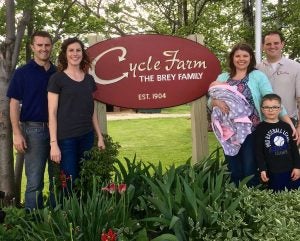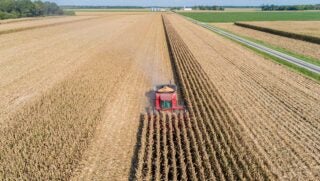Do you know the purpose, cause, or belief that drives you?
Author Simon Sinek calls this “finding your why.”
On my family’s dairy farm in Door County, Wisconsin, our why is, “To learn and adapt so that all may have a quality life.”
Every day, we face new challenges on Brey Cycle Farm. Although it has been in our family since 1904, the farm has changed to adapt to the changing world, much like other businesses do. Today, the farm is owned and managed by my husband and I along with his brother and sister-in-law.
A big part of our focus has become environmental stewardship. We continually adjust our conservation efforts to improve our care of the land and water. This is not only vital to the business today but also to our neighbors, our community, and the future generations who will hopefully carry on our dairy farming legacy.
To improve, we need to learn. Reading publications, talking to other farmers, and working with experts like our agronomist and nutritionist are a few of the ways this happens every day. There are also self-taught lessons, like trying something new and discovering that it works (or doesn’t!) and if there are ways to do it differently.
We are active in Peninsula Pride Farms, a farmer-led conservation group, and a member of the Door-Kewaunee Watershed Demonstration Farm Network. Both organizations provide opportunities to learn from peers and experiment with new practices that improve soil health and protect water quality.
We rely on science to identify where we can improve, to try different practices that fit our situation and measure the results.
For example, we have planted cover crops like winter wheat, winter rye, and triticale. These crops provide a growing plant on the land 365 days a year. This helps build soil health, minimize erosion, prevent nutrients from reaching streams or ground water, and improve wildlife habitat.
Our first year, we planted 200 acres of cover crops. This year we planted 500 acres, which is 80 percent of our eligible land; we plan to have 100 percent planted in cover crops this fall, if Mother Nature cooperates.

This year we are also trying interseeding a cover crop of clover into growing corn. In addition, we’ll be no-till planting corn after harvesting triticale and using a multi-species diverse cover crop mix after harvesting our winter wheat.
Not everything works and each farm is different, so the willingness to adapt is essential.
We work with our agronomist and local soil and water department to develop and implement a nutrient management plan, which documents strategies and practices we use to manage our land, including how manure, a terrific organic fertilizer, is applied to each field.
We try different manure application techniques. By using a dragline hose and low-disturbance injector, for example, we can put the nutrients below the soil surface, making it easier for the plants to use the nitrogen and phosphorous they need. The practice also reduces the manure odor.
To measure our improvements, we test the soil for pH, organic matter, phosphorous, and potassium. As part of the Demo Farm Network, soil samples are collected and will be retested to monitor the soil fertility changes over time.
Regulations change, too, calling for adjustments to our farming practices as well.
Intertwined into all of this are our changing business goals, which we re-evaluate regularly as the dairy economy changes and our families change. We realize we can’t farm the way our parents or our grandparents did.
We strive to be good stewards of the environment so that all — our neighbors, our communities, our employees and our families — may have a quality life.
So, our “why” happens every day.
Lauren Brey and her husband Jacob farm in Sturgeon Bay, Wisconsin, with Jacob’s brother Tony and sister-in-law Moriah. Brey Cycle Farm was established in 1904. Today, the Brey family milks 450 cows, raise their young stock and grow crops on 1,200 acres of land. They also raise beef animals.



